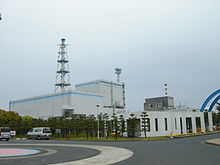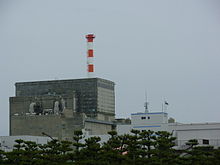Tōkai Nuclear Power Plant: Difference between revisions
Luckas-bot (talk | contribs) m r2.7.1) (robot Adding: es:Central nuclear de Tōkai |
|||
| Line 48: | Line 48: | ||
== Incident == |
== Incident == |
||
Following the [[2011 Sendai earthquake and tsunami]] the number 2 reactor was one of eleven nuclear reactors to be shut down automatically.<ref>{{cite web |url= http://www.news.com.au/world/japan-earthquake-evacuations-ordered-as-fears-grow-of-radiation-leak-at-nuclear-plant/story-e6frfkyi-1226020473244 |title=Japan earthquake: Evacuations ordered as fears grow of radiation leak at nuclear plant; News.com.au |first= |last=|work=news.com.au |year=2011|quote=According to the industry ministry, a total of 11 nuclear reactors automatically shut down at the Onagawa plant, the Fukushima No. 1 and No. 2 plants and the Tokai No. 2 plant after the strongest recorded earthquake in the country's history|accessdate=13 March 2011}}</ref> It was reported on 14 March that a cooling system pump for the number 2 reactor had stopped working.<ref>{{cite web |url= http://af.reuters.com/article/energyOilNews/idAFTKG00708120110313 |title=Cooling system pump stops at Tokai No.2 plant-Kyodo; Energy & Oil; Reuters|first= |last= |work=af.reuters.com |year=2011 |accessdate=13 March 2011}}</ref> Japan Atomic Power Company stated that there was a second operational pump and cooling was working, but that two of three diesel generators used to power the cooling system were out of order.<ref>{{cite web |url= http://uk.reuters.com/article/2011/03/13/uk-japan-quake-tokai-idUKTRE72C2RL20110313 |title=Tokai No.2 nuke plant cooling process working - operator | Reuters |first= |last=|work=uk.reuters.com |year=2011 |quote=Japan Atomic Power said Monday that the cooling process was working at its Tokai No.2 nuclear power plant's reactor although two of the three diesel power generators used for cooling were out of order. |accessdate=13 March 2011}}</ref> |
Following the [[2011 Sendai earthquake and tsunami]] the number 2 reactor was one of eleven nuclear reactors [[SCRAM|to be shut down automatically]].<ref>{{cite web |url= http://www.news.com.au/world/japan-earthquake-evacuations-ordered-as-fears-grow-of-radiation-leak-at-nuclear-plant/story-e6frfkyi-1226020473244 |title=Japan earthquake: Evacuations ordered as fears grow of radiation leak at nuclear plant; News.com.au |first= |last=|work=news.com.au |year=2011|quote=According to the industry ministry, a total of 11 nuclear reactors automatically shut down at the Onagawa plant, the Fukushima No. 1 and No. 2 plants and the Tokai No. 2 plant after the strongest recorded earthquake in the country's history|accessdate=13 March 2011}}</ref> It was reported on 14 March that a cooling system pump for the number 2 reactor had stopped working.<ref>{{cite web |url= http://af.reuters.com/article/energyOilNews/idAFTKG00708120110313 |title=Cooling system pump stops at Tokai No.2 plant-Kyodo; Energy & Oil; Reuters|first= |last= |work=af.reuters.com |year=2011 |accessdate=13 March 2011}}</ref> Japan Atomic Power Company stated that there was a second operational pump and cooling was working, but that two of three diesel generators used to power the cooling system were out of order.<ref>{{cite web |url= http://uk.reuters.com/article/2011/03/13/uk-japan-quake-tokai-idUKTRE72C2RL20110313 |title=Tokai No.2 nuke plant cooling process working - operator | Reuters |first= |last=|work=uk.reuters.com |year=2011 |quote=Japan Atomic Power said Monday that the cooling process was working at its Tokai No.2 nuclear power plant's reactor although two of the three diesel power generators used for cooling were out of order. |accessdate=13 March 2011}}</ref> |
||
==References== |
==References== |
||
Revision as of 05:10, 14 March 2011
This article needs additional citations for verification. (March 2011) |

The Tōkai Nuclear Power Plant (東海発電所, Tōkai hatsudensho, Tōkai NPP) was Japan's first nuclear power plant. It was built in the early 1960s to the British Magnox design, and generated power from 1966 until it was decommissioned in 1998. A second nuclear plant, built at the site in the 1970s, was the first in Japan to produce over 1000 MW of electricity, and still produces power as of 2009. The site is located in Tokai in the Naka District in Ibaraki Prefecture, Japan and is operated by the Japan Atomic Power Company.
Reactors on site
| Unit | Type | Average electric power | Capacity | Construction started | Construction completed | First criticality | Closure |
|---|---|---|---|---|---|---|---|
| Tōkai I | Magnox (GCR) | 159 MW | 166 MW | March 1, 1961 | November 10, 1965 | July 25, 1966 | March 31, 1988 |
| Tōkai II | BWR/5[1] | 1060 MW | 1100 MW | October 3, 1973 | March 13, 1978 | November 28, 1978 |
Unit 1

This reactor was built based on British developed Magnox technology. Unit 1 will be the first nuclear reactor to be decommissioned in Japan. The experience in decommissioning this plant is expected to be of use in the future when more Japanese plants are decommissioned. Below is a brief time-line of the process.
- March 31, 1998: operations cease
- March 2001: last of the nuclear fuel moved off-site
- October 4, 2001: decommissioning plan announced
- December 2001: decommissioning begins, spent fuel pool is cleaned
- 2003: turbine room and electric generator taken down
- Late 2004: fuel moving crane dismantled
- 2011: the reactor itself is dismantled
Unit 2
This Boiling Water Reactor was the first nuclear reactor built in Japan to produce over 1000 MW of electricity. By some formalities in the paperwork, the unit is technically separate from the rest of the nuclear facilities at Tokai-mura, but it is managed with the rest of them and even shares the same front gate.
Incident
Following the 2011 Sendai earthquake and tsunami the number 2 reactor was one of eleven nuclear reactors to be shut down automatically.[2] It was reported on 14 March that a cooling system pump for the number 2 reactor had stopped working.[3] Japan Atomic Power Company stated that there was a second operational pump and cooling was working, but that two of three diesel generators used to power the cooling system were out of order.[4]
References
- ^ "Reactors in operation". IAEA. 31 December 2009. Retrieved March 12, 2011.
- ^ "Japan earthquake: Evacuations ordered as fears grow of radiation leak at nuclear plant; News.com.au". news.com.au. 2011. Retrieved 13 March 2011.
According to the industry ministry, a total of 11 nuclear reactors automatically shut down at the Onagawa plant, the Fukushima No. 1 and No. 2 plants and the Tokai No. 2 plant after the strongest recorded earthquake in the country's history
- ^ "Cooling system pump stops at Tokai No.2 plant-Kyodo; Energy & Oil; Reuters". af.reuters.com. 2011. Retrieved 13 March 2011.
- ^ "Tokai No.2 nuke plant cooling process working - operator | Reuters". uk.reuters.com. 2011. Retrieved 13 March 2011.
Japan Atomic Power said Monday that the cooling process was working at its Tokai No.2 nuclear power plant's reactor although two of the three diesel power generators used for cooling were out of order.
External links
![]() Media related to Tōkai Nuclear Power Plant at Wikimedia Commons
Media related to Tōkai Nuclear Power Plant at Wikimedia Commons
